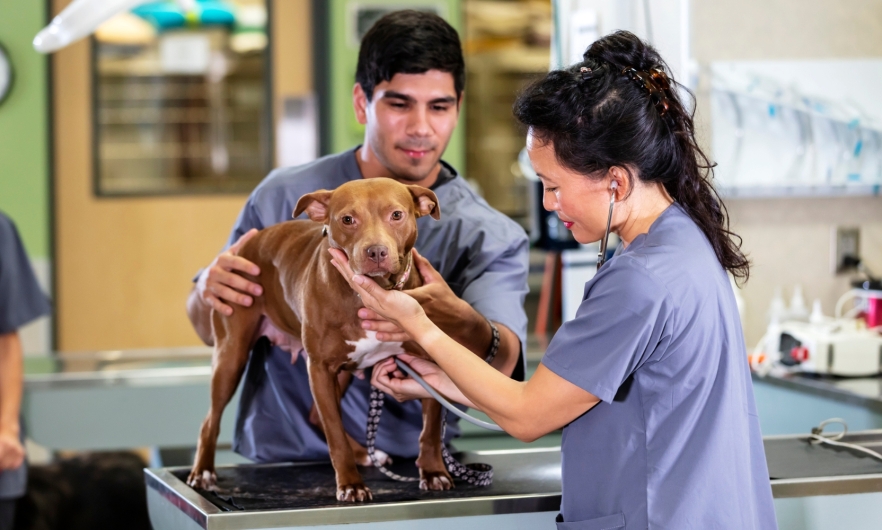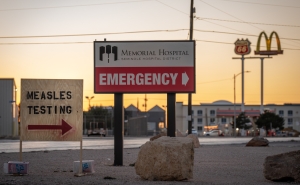What We Know—And Don’t Know—About Atypical Canine Respiratory Disease
Veterinarians are working to better understand the mysterious respiratory illness affecting dogs in the U.S.

Amid the usual upticks in COVID, flu, and RSV among humans this fall, another respiratory illness has been in the news—but this one is affecting dogs.
First reported in Oregon over the summer, veterinarians across the U.S. have reported cases of what is being called atypical canine infectious respiratory disease. While most cases are mild, some dogs develop more severe symptoms in as little as 24 hours.
In this Q&A adapted from the December 5, 2023 episode of Public Health On Call, Meghan Davis, DVM, PhD ’12, MPH ’08, a veterinarian and an assistant professor of Environmental Health and Engineering, explains what is known so far about this “mysterious” illness, how people can keep their dogs safe, and why disease surveillance in veterinary medicine isn’t nearly as comprehensive as it is for humans.
What do we know about this unidentified respiratory illness in dogs?
As of right now, we don't quite know exactly what it is, if anything, but it's being called atypical canine respiratory disease. We've had reports of mysterious illness in multiple states, but it appears to be a bit worse on the West Coast of the U.S.—a lot of the cases so far have been in Oregon.
The symptom we’ve associated most with this disease is cough, but having a cough doesn't necessarily mean that a dog has this particular syndrome. A cough can also be seen in many other fairly common illnesses that dogs get, like kennel cough. What’s raised concern is how quickly some dogs have become very sick.
To identify which cases may be specific to this unusual pattern, we try to establish a case definition and confirm that the dog isn’t sick with an illness we already know about. To do this, veterinarians collect samples from dogs presenting symptoms and send them to a lab to test them against known pathogens. A case definition could be built based on dogs that have these respiratory patterns—whether mild or more severe, but especially the most severe cases that progress to pneumonia and other outcomes—but test negative for those known pathogens.
It’s going to take some time to have enough samples of these cases and do further testing to answer questions like: Is this something that’s been around for a long time? Are there a bunch of different things causing illness? And are we just seeing cases now in the U.S. because we’re heading into winter, when we generally see lots of respiratory cases increase, or is this something new?
How many cases of sick dogs have there been?
We don't yet know, because we don't have a good surveillance system in place for animal health like we do for humans. In the U.S., the CDC has systems in place through local and state health departments to monitor cases of human disease. We have a lot of ability to treat and test lots of people, including those who may not have insurance, or who may come from diverse backgrounds.
Even though access to human health care can be limited in the U.S., it's not as limited as access to veterinary medicine—where you have to pay to go to a veterinarian. This means we don't necessarily know about all cases of an illness or have a strong system in place to do testing on every single animal. That may limit our ability to understand what’s going on.
Why are people alarmed about this?
There’s cause for concern when we see that kind of speed and severity of disease in dogs. Not only are some pets requiring additional treatment for a lingering cough, but some are needing hospitalization, or at risk of death.
Fortunately we are much better at recognizing it in our “pandemic plus” era—this period of time after the official pandemic has ended, when there’s still lots of disease in humans caused by SARS-CoV-2, as well as influenza and RSV.
Do we know what's causing this? Is it a bacteria, a virus, or a fungus?
We're still in a very early stage, so I would not hazard a guess as to what it will end up being, or if it will even just be one thing. There are a number of teams doing testing, and some of the early results suggest that there may be a bacterium involved, but it's not clear whether that’s the causative agent across the board.
That being said, sometimes when you have a case definition, it's not all caused by the same thing, and it’s not necessarily an emergent or novel pathogen. Looking to see if that may be the case is a prudent thing to do, and that's what's happening. We'll know more as we get more results from research teams and veterinary diagnostic laboratories.
As we start to dig into the diagnostics, I'm curious to see if this is indeed something emergent, or if what we're seeing is actually just better reporting and care seeking by owners, and what we’re witnessing now has actually been around for a while. We would be able to understand how that known illness has developed over time.
How are dogs getting sick?
Infectious disease transmission usually occurs through either direct or indirect contact. That means that the dogs at highest risk are those that travel a lot or that have a lot of contact with other dogs—at dog parks or boarding facilities, for example. But that risk can vary. If you have a small group, and it's always the same dogs that are in that group, the risk may be lower than a dog in a kennel that has a lot of different dogs coming in and out.
Could this illness spread to humans?
At the moment, I have not seen any evidence for this. Whether it could happen sporadically remains to be seen.
Are there ways to monitor the potential for spillover?
It takes very strong One Health surveillance systems to be able to identify cases or events that may not happen all the time. With a One Health surveillance system, we’re looking for cases of disease in both humans and animals—and also the environment, if that’s part of the pathogen’s transmission pathway—to identify possible connections. For example, if cases happen around the same time or in the same household. This requires a lot of communication between human health officials and animal health agencies, and anyone who might be involved on the environmental health side.
What lessons can we learn from this kind of an outbreak? How can we keep everyone safe going forward?
The biggest thing we need to do is continue to invest in surveillance systems, especially given the lessons the pandemic has taught us.
On the animal health side, we have a number of ways veterinarians can report unusual disease, and there are some ways by which we can link these data to the same kinds of events in people. I would like to see this kind of reporting become more systematic and allow us to see potential links in real time. In instances in which we might see disease in both people and animals, this would make it possible for animal health and human health authorities to work together and respond as quickly as possible.
It would also be useful to improve diagnostics on the veterinary side. Our animal health laboratories are wonderful and have great resources, but they are not necessarily on the level of some of the human diagnostic laboratory systems. Being able to do more routine testing—especially in the cases where owners would not otherwise be able to afford testing—would allow us to have better surveillance across a larger group of dogs. By expanding testing, we could track and monitor data from environments that may carry higher risk due to more crowding of dogs or other kinds of exposures.
How can we keep our pets safe?
As with any infectious respiratory disease, if people are concerned, they should limit their dog’s exposure to high-risk environments. If you’re planning to travel and are going to have your pet boarded—make sure that they're vaccinated against all of the usual suspects.
Stephanie Desmon is the co-host of the Public Health On Call podcast. She is the director of public relations and communications for the Johns Hopkins Center for Communication Programs, the largest center at the Johns Hopkins Bloomberg School of Public Health.





